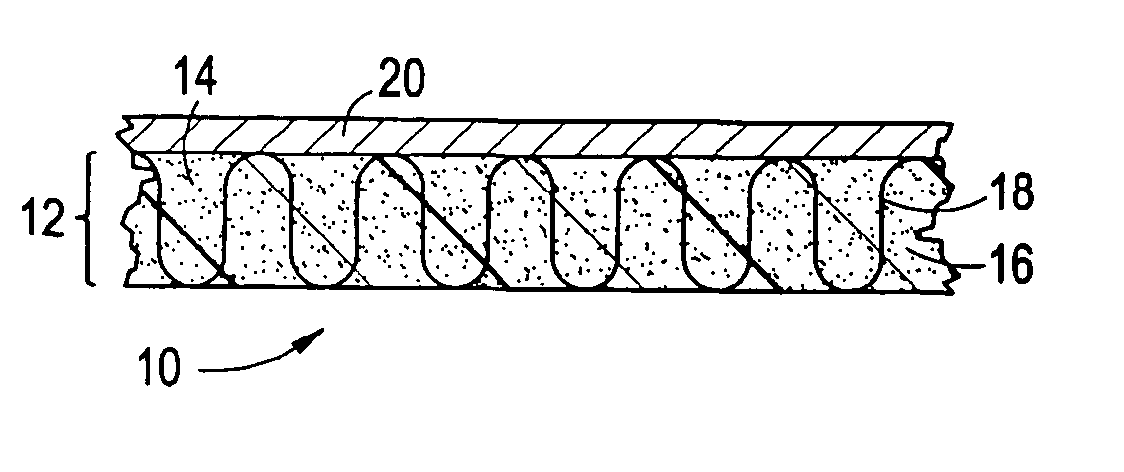Circuit materials, circuits, multi-layer circuits, and methods of manufacture thereof
a technology of circuit materials and polymer materials, applied in the field of dielectric materials, can solve problems such as detriment to the electrical properties of laminates made of polymeric materials, and achieve excellent electrical and physical properties
- Summary
- Abstract
- Description
- Claims
- Application Information
AI Technical Summary
Benefits of technology
Problems solved by technology
Method used
Image
Examples
example 1
[0062] In this example, a composite materials system was made containing 33.5 parts by weight PM1284×47.1 parts by weight CE 44i, and 0.7 parts by weight dicup. These components were mixed in xylene at a concentration of 50% solids by weight, then coated onto style 1080 woven glass cloth, such that the cloth provided 18.8 parts by weight on a dry solids basis. The dried pre-preg was then laminated between two sheets of copper foil at the temperature profile shown in Table 2, wherein heating stage 4 was carried out at 250° C. for 1 hour. The resultant laminate had excellent dielectric properties, as shown in Table 2.
example 2
[0063] In this example, a composite material system was made containing 31.4 parts by weight PM1284X, 3.2 parts of PS782, 49.5 parts by weight CE 44i, and 0.7 parts by weight dicup. These components were mixed in xylene at a concentration of 50% solids by weight and coated onto glass cloth such that the cloth provided 15.2 parts by weight on a dry solids basis. The dried pre-preg was then laminated between two sheets of copper foil at the temperature profile shown in Table 2, wherein heating stage 4 was carried out at 250° C. for 1 hour. The resultant laminate had excellent dielectric and flame retardant properties as shown in Table 2.
TABLE 2CTE,SpecificWater Abs.CTE, x axisCTE, y axisz axisFlamegravityEx.Dk*Df(%)(ppm)(ppm)(ppm)(UL-94)(g / cc)13.410.00710.449.48.614.2V-01.7923.3 0.00730.738.59.715.7V-01.76
*Dielectric constant was determined at a frequency of 4 GHz.
examples 3-8
[0064] In these examples, composite materials systems were made containing 40.2 parts by weight of a blend of PM1284X and an additive A (see Table 3 for the ratios of additive A to PM 1284×), 47.4 parts by weight CE 44i, 0.4 parts by weight A-171, 0.4 parts by weight A-171, and 0.7 parts by weight dicup. These components were mixed in xylene at a concentration of 50% solids by weight, then coated onto glass cloth, such that the cloth provided 18.8 parts by weight on a dry solids basis. The dried pre-preg was then laminated between two sheets of copper foil using the temperature profile in Table 2, wherein heating stage 4 was carried out at 290° C. for 2 hours, unless otherwise indicated. Properties of the resulting laminates are given in Table 3 below.
TABLE 3RatioWaterFlameExam-Additiveof A toAbs.Retardanceple(A)PM1284XDkDf(%)(UL-94)3PBD25:753.410.00600.67T1 > 30 sec4PBD50:503.180.00440.73T1 > 30 sec5PBD75:253.280.00470.41T1 > 30 sec6M-PBD38:623.360.00631.03T1 > 30 sec 7*TAIC13:87...
PUM
| Property | Measurement | Unit |
|---|---|---|
| Frequency | aaaaa | aaaaa |
| Temperature | aaaaa | aaaaa |
| Temperature | aaaaa | aaaaa |
Abstract
Description
Claims
Application Information
 Login to View More
Login to View More - R&D
- Intellectual Property
- Life Sciences
- Materials
- Tech Scout
- Unparalleled Data Quality
- Higher Quality Content
- 60% Fewer Hallucinations
Browse by: Latest US Patents, China's latest patents, Technical Efficacy Thesaurus, Application Domain, Technology Topic, Popular Technical Reports.
© 2025 PatSnap. All rights reserved.Legal|Privacy policy|Modern Slavery Act Transparency Statement|Sitemap|About US| Contact US: help@patsnap.com



